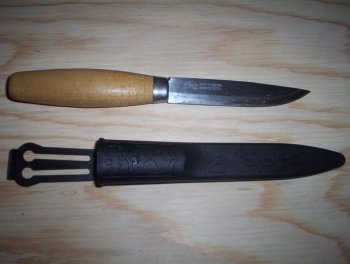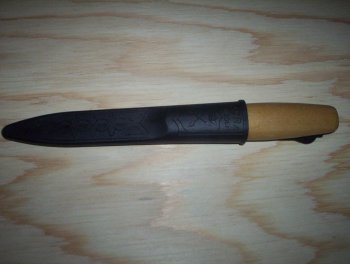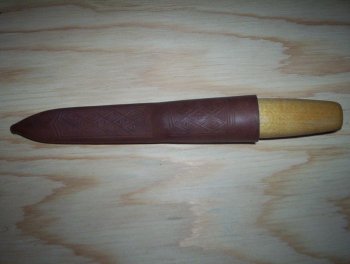*Hot Waxing Leather Sheaths*
Traditional Leather Protection
By: OhCanada
06 May 2006
There are many approaches to sheaths: leather, nylon, plastics of various names, and even wood. What you use may depend on your job, your environment, or your personal esthetic.
My own choice is for quick drying synthetics but sometimes a traditional knife just needs a traditional sheath. Hot waxing is a natural method you can do at home to protect a leather sheath, add some colour, and make it harder.
I have long been a fan of Mora knives but these usually come with red painted wood handles or plastic handles and plastic sheaths. So when I found a Mora with a natural wood handle I just had to have a leather sheath for it. I bought one from www.ragweedforge.com but did not opt for the hot wax treatment, as I wanted to try and learn to do it myself.

The laminated steel Mora knife with original plastic sheath.
So this article will be about what I did to hot wax my sheath and how you can do it too. I am sorry that I didnít think to take photos of the process at the time, so all photos you see here of the sheath are post-waxing.
Tools:
* Leather sheath (any style but needs to be natural unfinished leather)
* Beeís wax (I used a bees wax candle from a hiking shop, that one candle could easily finish two Mora sheaths)
* Pot and tin can
* Hair Dryer
* Stove
* Toothbrush (will be ruined by the process)
Method:
- Fill a saucepan half full of water and put your tin can containing your wax inside (you may have to use pliers to keep the can upright if it wants to float). Turn your stove to around medium heat, too much heat and you may set the wax on fire, you want just enough heat to melt the wax to liquid without causing it to boil.
- The reason for the hair dryer is to allow you to heat the sheath while holding it. The reasoning here is that if the heat is too much for your hand then it is also too much for the leather (a type of skin). I did not have a hair dryer so I used a wood spoon to hold the sheath in the middle of my open oven watching carefully that it did not burn. The disadvantages of using the wood spoon is that it did not hold the sheath firmly or allow me to feel the same temp the sheath was being subjected to.
- Once the sheath has been heated to "warm" you dip your toothbrush into the melted wax and slather it onto the sheath. It will look rather ugly and turn white but that is ok, as subsequent re-heats will work the wax into the leather. I only put one coat on the belt loop because I didnít want to make the loop too hard. After the first coat had dried (a matter of several seconds) I put it back into the heat until the excessive wax melted and soaked into the sheath. In all, I did this four times to the main body of the sheath. For the last heating I had a sheet of paper towel ready to gently wipe down any excessive wax, as I would not be heating it again. Play around to see how many layers of wax you want on your sheath.
- It is also important that as soon as you finish the last coat that you put the knife into the sheath so the still warm sheath can mold around the knife.
- I have known some people to dip the whole sheath into a can of melted wax but I prefer the hands on approach and control of each layer of wax.

- Plastic sheath.

- Leather sheath after hot wax treatment.
OhCanada
www.alpharubicon.com
All materials at this site not otherwise credited are Copyright © 1996 - 2006 Trip Williams. All rights reserved. May be reproduced for personal use only. Use of any material contained herein is subject to stated terms or written permission.



